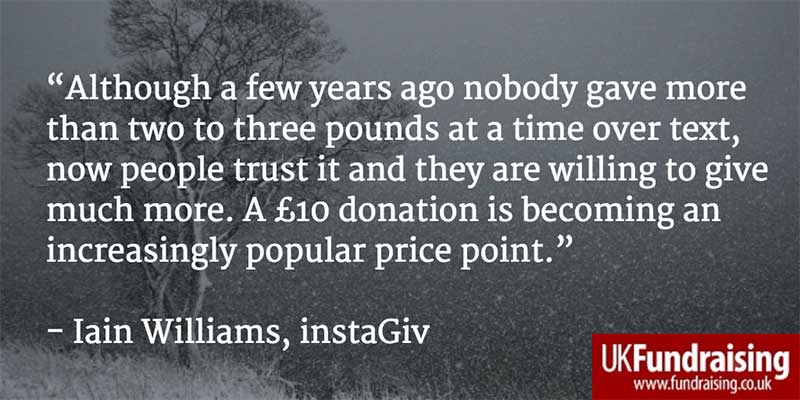Fundraisers and mobile industry debate the potential of SMS fundraising
Last month UK Fundraising in association with mobile giving provider instaGiv hosted a roundtable in London to discuss the current and future opportunities of giving to charity by SMS text. Senior fundraising staff together with representatives of regulatory and trade bodies attended the event at NSPCC’s London office.
2014 was the biggest year yet for SMS text donations from mobile phones with more than £115 million donated in this way and £124 million forecast for 2015, according to PhonePayPlus. Stand out viral campaigns like the #IceBucketChallenge #NoMakeUpSelfie and the poignant #StephensStory led hordes of people to make their first ever text donations but charities confessed they had yet to make the most of mobile text as a channel.
SMS for one-off gifts or more complex supporter communications?
Charity panellists at a roundtable event on SMS text, hosted by UK Fundraising in association with mobile giving provider instaGiv, were asked whether text had really reached its potential as a simple one-off gift mechanism ideal for disaster appeals and viral campaigns or if there is greater potential yet to be achieved for more complex donor communications for regular giving and supporter engagement.

Iain Williams of instaGiv: more scope for regular giving and engagement from SMS
Iain Williams, a director of instaGiv asserted that charities have “just hit the tip of the iceberg” when it comes to donor acquisition and that there is significantly more scope for conversion to regular giving and being creative in the use of the mobile channel for engagement.
Representatives from Amnesty International, British Red Cross, Macmillan Cancer Support, Oxfam and NSPCC, as well as industry bodies the Institute of Fundraising, AIME and the DMA discussed the shared challenge of converting one-off text donors, largely secured through social media campaigns and broadcast advertising, to become regular givers.

l-r: Daniel Fluskey (Iof), Wanji Wambari-Kairu (Macmillan Cancer Support), Mark Brill (Chair of the DMA’s Mobile Marketing Council)
The fact that most of us have a mobile phone on us at all times these days means the audience reach is there, and, for charities, the ability to combine both communication channel and payment in one device is highly beneficial. Outbound texts are a cost-effective way to reach out to existing and prospective supporters, yielding good response rates, especially so when the content is relevant and engaging.
Across the table, the consensus from charities was that text giving has yet to reach its potential. By integrating text short-codes into more communication channels, growing regular giving and finding other ways to use text to involve supporters in the charity’s work, charities can grow both income and a deeper engagement with supporters for longer-term and valuable relationships.

Wanji Wambari-Kairu, Macmillan Cancer Support: make text part of the donor journey from the start
Wanji Wambari-Kairu, Individual Marketing Programme Manager at Macmillan Cancer Support said:
“SMS should be used as part of your communication channels, adding keywords into appropriate creative, making text part of the journey right at the start.”
Advertisement
From £2 to £10 gifts
When it comes to the public, text is a quick and easy way to give. Making a donation is spontaneous and almost immediate, while it’s secure via the mobile phone provider that the donor is likely to trust, and there are no lengthy forms to fill out, no mandates, and, importantly, no need to share bank details.
Iain Williams added:
“Although a few years ago nobody gave more than two to three pounds at a time over text, now people trust it and they are willing to give much more. A £10 donation is becoming an increasingly popular price point.”
Role of call centres
Charities can raise huge amounts of money in a short time frame, but if they only have a mobile telephone number, fundraisers are understandably reticent to over use what is often perceived as a very personal communication channel.
Following up with a call-centre phone call to one-off donors to convert them to regular giving is a common practice, but “that phone call can be a turn off,” advises Williams.
“While text donors are happy to give, some simply don’t want to talk on the phone. It may be worth texting first to gain permission to call, or to make the ask directly by text.”
“One of the strengths of text is that it gives donors more flexibility over when and how they give, offering greater control from the donor perspective – regular donors can receive SKIP notifications which allow them to opt out of a certain month’s payment during tighter months, without necessarily stopping altogether.”
Anonymity is important to some donors
Charities continue to trial a number of different approaches to engage with donors via text, testing what is the most effective way of converting one-off supporters to regular givers, how soon to get in touch about Gift Aid and how often they can message supporters.
“One of the reasons that some people give this way is because of the anonymity,” says Kate Ixer, Digital Fundraising Officer at the British Red Cross.
“We are looking at ways of optimising the process, how to contact people without being too intrusive. It’s all a question of finding the right balance.”
Converting to monthly giving
The challenge is to convert more single donation texts to monthly giving, while ensuring that donors’ contact preferences are taken into account. Bearing in mind the necessity to message regular supporters monthly advising them that they can STOP and SKIP donations, as well as verification messages and Gift Aid declarations, panellists at the roundtable event queried how often they can contact text donors without overstepping the mark.
“Already we have to contact donors monthly with a SKIP message, coupled with messages around our emergency campaigns. How many more times do we get in touch by text without spamming them?” one participant asked.

Participants in SMS fundraising roundtable
Mobile industry views
Expert insights were presented by industry representatives from the Association of Interactive Media & Entertainment (AIME), Institute of Fundraising and the DMA’s Mobile Marketing Council.

Rory Maguire, Managing Director of AIME
“Success from text giving can be phenomenal, but it tends to be short lived,” says Rory Maguire, Managing Director of AIME.
“Charities need to work at prolonging that relationship with the consumer and making better use of Gift Aid.
“The ability to link is important and you can move supporters into other platforms like social media channels such as Snapchat and Facebook, building in multiple ways to communicate, all originating from text.”

Mark Brill: engagement before fundraising?
Mark Brill, Chair of the DMA’s Mobile Marketing Council and founder of Formation added:
“I understand that charities need the quick wins when it comes to fundraising, but the danger here is that you start out with fundraising and following up with engagement when – in an ideal world we should turn this on its head. Should it not be the case of thinking about what engagement we want and building from there?”
“Mobile has many engagement tools. Better use of these and a deeper engagement is what will keep supporters for the longer term, especially in a changing digital landscape.”
Tim Hunter, Fundraising Director of Oxfam UK, agreed, adding,
“Engagement is key, but we need to have a clear mechanism by which engagement turns to cash. The real advantage for us with text is that it combines communication and payment all in one device.”
What about growth of other messaging platforms?

Tamsin Fidgeon, Amnesty International UK
While charities test new ground with the frequency, length and content of text messages, other messaging platforms such as Viber and WhatsApp are rapidly gaining ground. However, none are as ubiquitous as text or are a match for collecting donations.
Amnesty International’s Pocket Protest appeal was cited as a strong example of a successful engagement campaign that also raises funds.
[message_box title=”Amnesty’s Pocket Protest” color=”blue”]
Amnesty devised its Pocket Protest campaign as a way for people to sign up to petitions and to engage with the charity online. Currently, almost 70,000 people are on their network now, having seen adverts about the campaign via press and online.
Once a supporter signs up to the network, they receive action texts calling on their support for petitions, with links to online campaigns.
“The primary purpose of Pocket Protest is to engage with our supporters via text about urgent cases that require immediate action”, says Tamsin Fidgeon, Digital Communications Executive at Amnesty International.
“As the donor has chosen to communicate with us by text, we then continue to communicate with them that way. We will send donation requests when appropriate for certain cases, no more than four a year.”
[/message_box]
While this campaign is well suited to Amnesty’s core focus, this type of approach could work well for others. The need to raise funds for campaigns, particularly emergency appeals, is a priority, but charities were encouraged to focus on donor engagement at the outset and to better integrate text across their communication channels.
Learning more about what supporters want
In building a stronger relationship and continuing to test their approach, charities can gain a better understanding of what supporters want and how to maximise returns with a mobile channel that continues to evolve. New developments are making the channel ever more effective, instaGiv has recently launched iAddress, a function that enables the collection of a donor’s name and postal address via a simple request in the donation confirmation/thank you message. So too, to meet the needs of charities we should expect to see functionality for Gift Aid collection and more creative techniques for engaging supporters through their mobiles.
Maguire concluded:
“SMS is a core component of everybody’s pocket computer; their phone. It works on every handset on every network across the world. Charities can’t afford to dismiss it, but don’t capitalise on it alone.”
[message_box title=”In association with instaGiv” color=”blue”]
Established in 2010 specifically to serve charities, instaGiv is today a leading provider of mobile phone text messaging services for supporter engagement, fundraising, and donor communications. In the last 12 months instaGiv has helped charities across the UK raise over £5million in donations via text messages. instaGiv’s services provide a fast and unobtrusive way to help charities raise donations on a one-off or regular basis; and its focus on the donor journey enables charities to connect and engage with new supporters, and capture accurate donor information that can be added to databases for on-going communications, regular giving programmes and long-term stewardship.
Founder Michael Carlin, recognised the way in which the market was not responding to the needs of the charity sector and set up instaGiv with a top team of experts in management and telecommunications. instaGiv’s client portfolio encompasses a wide range of charities, including: Amnesty International, Macmillan Cancer Support, British Red Cross, Alzheimer’s Society, Action for Children, Prince’s Trust, Breast Cancer Campaign, and more. InstaGiv is proud to offer flexible and adaptable services to suit the needs of all charities no matter their size.
[/message_box]





